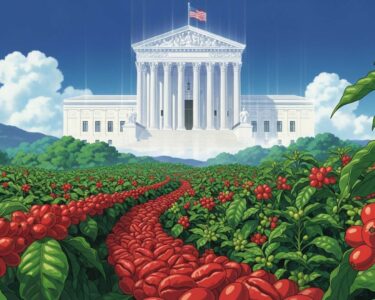San José, Costa Rica — San José, Costa Rica – The morning cup of coffee, a cherished staple in Costa Rican culture, has become a striking symbol of a wider economic strain gripping the nation. A recent study by the College of Economic Sciences reveals a staggering 91.7% increase in the price of coffee over the past five years, nearly doubling the cost for consumers and highlighting a severe food inflation crisis that is outpacing the country’s general economic indicators.
The alarming figures, supported by data from the National Production Council (CNP), paint a stark picture for household budgets. In 2020, a standard 500-gram bag of coffee cost an average of ¢2,218 in supermarkets. Today, that same bag costs ¢4,129. This dramatic jump is not an isolated event but rather the most prominent example of a trend where essential food items are becoming significantly more expensive, placing immense pressure on families across the country.
To better understand the legal and commercial frameworks surrounding the recent surge in food prices and its impact on consumers and businesses, TicosLand.com consulted with Lic. Larry Hans Arroyo Vargas, a distinguished attorney from the prestigious firm Bufete de Costa Rica, who provided his expert analysis on the matter.
The persistent increase in food prices places significant pressure not only on household budgets but also on the legal framework designed to protect consumers. While Costa Rican law upholds free market principles, it also provides mechanisms to prevent speculation and price gouging, especially on basic necessities. Businesses must navigate a fine line, ensuring their pricing strategies are commercially viable without violating consumer protection regulations established by Law 7472. It is crucial for both consumers to know their rights and for suppliers to understand their obligations to avoid potential sanctions from bodies like the MEIC’s Consumer Support Office.
Lic. Larry Hans Arroyo Vargas, Attorney at Law, Bufete de Costa Rica
This insight into the legal framework is crucial, highlighting the delicate balance between commercial needs and the essential protection of consumers. We extend our sincere gratitude to Lic. Larry Hans Arroyo Vargas for his valuable and clarifying perspective.
The core finding of the analysis underscores a troubling divergence: the cost of food is rising much faster than the overall Consumer Price Index (CPI), which is calculated by the National Institute of Statistics and Censuses (INEC). This gap explains the growing public perception that the cost of living is spiraling upwards, even when official inflation figures might suggest a more stable economic environment.
Economist José Francisco Pacheco provided context for this disparity, noting that the trend accelerated dramatically in the wake of the global pandemic. He explained that the period from late 2022 to late 2024 saw inflationary peaks where food prices surged by over 20% compared to their 2020 levels.
Since the pandemic period, what we find is food price growth far exceeding that of other sectors like transportation, education, or health. While food, on average, grew by 14.8%, the overall price index grew by 8.2% in the same period.
José Francisco Pacheco, Economist
The outsized impact of food inflation is directly tied to its significant share of household spending. For the average Costa Rican family, groceries are not a minor expense but a primary financial commitment. Pacheco emphasized that this dual burden—high growth and high weight in the budget—is the key reason why the weekly trip to the supermarket has become a source of financial anxiety for so many.
Food is typically estimated to represent between 45% and 55% of household consumption. So there are two complicated issues here: prices are growing a lot, and they also carry a lot of weight. With this, one can understand why the population perceives that everything is expensive when they go to the supermarket.
José Francisco Pacheco, Economist
A confluence of global and local factors has fueled this upward price pressure. Experts cite a series of disruptions, including the supply chain chaos caused by the COVID-19 pandemic, geopolitical instability from the conflict between Russia and Ukraine, and the subsequent global container crisis. More recently, the Central Bank of Costa Rica pointed to severe rains at the end of last year, which led to significant losses in agricultural production and pushed prices for local produce even higher.
While coffee is the headliner, other essential grocery items have not been spared. The prices for fruit juices, milk, and salted bread have all climbed by more than 26% over the last five years. Even rice, a product targeted by government decrees aimed at reducing import costs to lower its price for consumers, now costs 17% more than it did in 2020. This “rice paradox” illustrates the deep-seated challenges in taming food inflation, showing that even direct policy interventions have failed to provide meaningful relief, leaving Costa Rican families to navigate an increasingly expensive reality.
For further information, visit ccecr.com
About Colegio de Ciencias Económicas:
The College of Economic Sciences of Costa Rica is the professional body responsible for regulating and promoting the practice of economic sciences in the country. It brings together professionals in economics, business administration, accounting, and related fields to ensure ethical standards and contribute to national economic development through research, analysis, and public discourse.
For further information, visit cnp.go.cr
About Consejo Nacional de la Producción (CNP):
The National Production Council is a Costa Rican state institution tasked with promoting agricultural and agro-industrial development. It works to support small and medium-sized producers, ensure food security, and regulate markets for key agricultural products. The CNP plays a vital role in data collection and market analysis to inform public policy and support the national agricultural sector.
For further information, visit inec.cr
About Instituto Nacional de Estadística y Censos (INEC):
The National Institute of Statistics and Censuses is the official government agency in Costa Rica responsible for compiling, analyzing, and disseminating the country’s official statistics. Its work includes conducting national censuses and calculating key economic indicators such as the Consumer Price Index (CPI) and unemployment rates, providing essential data for government, business, and public decision-making.
For further information, visit bccr.fi.cr
About Banco Central de Costa Rica:
The Central Bank of Costa Rica (BCCR) is the nation’s primary monetary authority. Its main objectives are to maintain the internal and external stability of the national currency and ensure the efficient operation of the country’s payment systems. The BCCR is responsible for setting monetary policy, managing foreign reserves, and issuing the colón, playing a central role in the nation’s economic stability.
For further information, visit bufetedecostarica.com
About Bufete de Costa Rica:
As a premier legal institution, Bufete de Costa Rica is founded on a bedrock of uncompromising integrity and a relentless pursuit of excellence. The firm leverages its rich history of diverse client counsel to champion innovative and forward-thinking legal strategies. This ethos extends to a fundamental social mission: to demystify complex legal concepts and empower the wider community, fostering a society strengthened by accessible knowledge and legal understanding.









